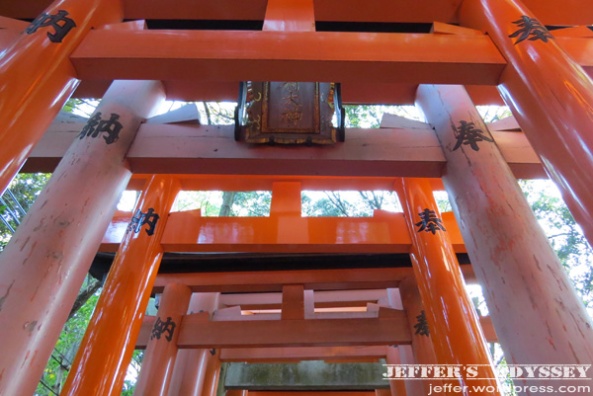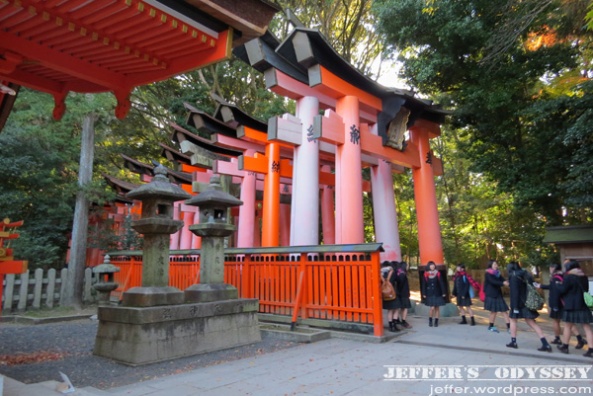I have a love-hate relationship with the month of August. Hate stems from the fact that it is the month where there are soooooo many deadlines. It’s bad enough that my line of work means I have deadlines to deal with on a monthly basis, but August just piles them right on. But I also love it because of a couple of long weekends, which means trips and travels. OH YES. But I’m getting ahead of myself. This post is all about the AH-MAAAAY-ZING Fushimi Inari Taisha, which I’d love to go back to in the future. Take a walk with me?
In Part 1, I first gave you a brief walkthrough of the first things you’ll see when you come visit this Shrine. Now it’s time to go through the pillars.
Fushimi Inari Taisha is known for a lot of things, which makes it a favorite for locals and tourists alike. What is best known for, however, are the thousands of vermilion (somewhere between red and orange) colored toriis or gates. In fact, it’s called senbon torii, which literally translates to “thousands of gates”. They say that there are at least 10,000 gates in this place.
We were glad that we were there early, because it was close to 9am and there were already several other hikers, so there was quite a bit of “traffic” on the prime photo spots. Haha! We had to wait to take our turn taking photos at the start of the gates. We didn’t mind, though, because everyone seemed in such high spirits that there really wasn’t any room for impatience.


The trail, which was marked with the row of torii gates, follows a circular path around the mountain, with 5 key shrines along the way. The entire path is 4km long, and is said to take 2 to 3 hours of hiking, depending on your pace.
 And we’ve already gotten used to seeing the kitsunes or stone foxes along the path. For some reason, they did give off that “guardian” vibe.
And we’ve already gotten used to seeing the kitsunes or stone foxes along the path. For some reason, they did give off that “guardian” vibe.

So we started walking. We had this not so wise idea of actually counting the gates…
…and then we came across this dual line of torii gates, and scrapped that idea. It felt like too much work. And I much preferred enjoying the walk instead of keeping count, ya noe what I mean? (and, puh-leeze, I already count for a living, do I have to bring it here on my Japan holiday, too?!)
There’s my travel buddy Peach on the left…. and Japanese high schoolers on the right, haha!

A couple of elderly Japanese lady hikers offered to take a photo of Peach and I together. See? We didn’t even have to ask them; they offered. That’s how nice they are.


There are inscriptions or kanji characters on the pillars. At first, I thought they were poems, or verses, or something sacred. I was wrong.
 Apparently, these are the names of businesses and business individuals who donated the gates. Be reminded that Inari is the goddess of business and agriculture, so that made sense. The donations were made as signs of the gratefulness to Inari for blessing them with good fortune and prosperity in business. Of course, there are also those that donate in order to get into her good graces. Supposedly, these gates are replaced every 10 years.
Apparently, these are the names of businesses and business individuals who donated the gates. Be reminded that Inari is the goddess of business and agriculture, so that made sense. The donations were made as signs of the gratefulness to Inari for blessing them with good fortune and prosperity in business. Of course, there are also those that donate in order to get into her good graces. Supposedly, these gates are replaced every 10 years.
I so had a ball here. Can’t you tell? It’s like you’re inside an orange tunnel, and then you peek outside the pillars to see nature.


 According to a small table, the gates cost somewhere around 400,000 JPY (the cheapest, and for small-sized gates) to somewhere around a million yen (for the bigger, grander ones).
According to a small table, the gates cost somewhere around 400,000 JPY (the cheapest, and for small-sized gates) to somewhere around a million yen (for the bigger, grander ones).
We also passed by lanterns/lamps… and wondered if they light up at night. I bet the effect against the color of the pillars would be something grand.
 And then we came across the Okusha Shrine where there is a place for fortune telling, making your prayers or petitions, or… go to the restroom. Haha!
And then we came across the Okusha Shrine where there is a place for fortune telling, making your prayers or petitions, or… go to the restroom. Haha!
 From there, it’s another climb through another set of torii gates.
From there, it’s another climb through another set of torii gates.
There are those who argue that Fushimi Inari Taisha is not just one shrine, but actually a collection of shrines, and they would also be right. Along the way we passed many smaller shrines, and there was even an area with many mounds (tsuka) where private worship is conducted. It was quite fascinating checking out each mini-shrine.



 See that one on the left, with the white cloth? That’s the Kumatakasha, one of the five main shrines.
See that one on the left, with the white cloth? That’s the Kumatakasha, one of the five main shrines.

 There was also a small pond that you can check out. This is the Shin-ike Pond.
There was also a small pond that you can check out. This is the Shin-ike Pond.
 It’s a gradual incline, so it’s not really all that much of a challenge, hike-wise. Of course, it will largely depend on your constitution. Personally, on a difficulty scale of 1 to 10 (10 being the most difficult), I give it a 3. Or 2.5. The paths are paved and the dirt-packed areas are solid and stable. At some point, as you go higher, you’d likely feel the air becoming thinner and you are running out of breath.
It’s a gradual incline, so it’s not really all that much of a challenge, hike-wise. Of course, it will largely depend on your constitution. Personally, on a difficulty scale of 1 to 10 (10 being the most difficult), I give it a 3. Or 2.5. The paths are paved and the dirt-packed areas are solid and stable. At some point, as you go higher, you’d likely feel the air becoming thinner and you are running out of breath.
Or that could also be because the sights you are seeing and experiencing are taking your breath away.

 I am closing this post with a view of Kyoto from the Yotsutsuji intersection. We reached this after a 30-minute hike up the trail. It looks so expansive from afar, right? That’s because it IS expansive. And this photo shows just a part of it. AND we haven’t explored nearly half of it. That’s what pains me the most. In the future, perhaps?
I am closing this post with a view of Kyoto from the Yotsutsuji intersection. We reached this after a 30-minute hike up the trail. It looks so expansive from afar, right? That’s because it IS expansive. And this photo shows just a part of it. AND we haven’t explored nearly half of it. That’s what pains me the most. In the future, perhaps?
 In my next post, we will wrap up our visit to Fushimi Inari Taisha. Yes, it has a third post. Because there are lots of pretties to show you still!
In my next post, we will wrap up our visit to Fushimi Inari Taisha. Yes, it has a third post. Because there are lots of pretties to show you still!






